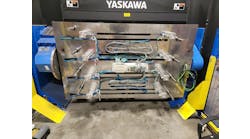System integrator Patti Engineering and Kettering University share a long history. Not only is Patti Engineering CEO Sam Huff a Kettering graduate, so is the company’s vice president of engineering, Dave Foster, and electrical engineers Brad Grabow and Abby Engle. Patti Engineering also employs two Kettering co-op students, Scott Grunwald and Nathan Kramer, and along with Mitsubishi Electric Automation and BorgWarner joined forces to provide Kettering University students with an interactive learning tool for robotic cell programming.
Kettering University is known for its engineering, technology and applied sciences academics, and the university offers a co-op education model. The cooperative program allows students to alternate between academic terms and professional work experiences, applying classroom theory with real-world application.
Get your subscription to Control Design’s daily newsletter.
Mitsubishi Electric is dedicated to workforce development issues through its program Diamondworks!, which partners with schools that teach manufacturing and automation concepts to students. “Our program offers tons of great resources to educators including curriculum, instructor training, hardware and software discounts and access to some of the brightest engineers in the industry. That is why this project made sense for us,” says Tom Majewski, workforce development manager at Mitsubishi Electric Automation.
Mitsubishi already had a good working relationship with Patti Engineering, so it approached the system integrator about helping to develop the project. Patti Engineering donated initial system concepts and engineering time. Mitsubishi provided equipment at a discounted rate, and the project received a substantial donation from propulsion system supplier BorgWarner.
The work cell learning tool will allow students to program and debug robots, programmable logic controllers (PLCs), human-machine interfaces (HMIs) and vision systems. The robotic cell is a student experimentation lab with the ability to modify or rewrite the programming and includes two stations with an industrial robot and a collaborative robot (cobot). The industrial robot, equipped with a Keyence 3D vision system, picks custom-made medallions from a bin. The vision system can identify and locate the medallions regardless of their orientation, and the robot places the medallions on a roller conveyor leading to the second station.
There, the cobot picks up the incoming medallions. A separate camera inspects the medallions to determine the orientation—heads or tails—and tracks the finds and then returns the medallions to the original bin via a powered conveyor, back to where they started. “It’s a matter of beginning with the end in mind. We knew the key applications and technologies we wanted the students to learn. From there it was a matter of bringing in the engineers to turn this conceptual idea into a functional system. After several meetings and iterations of the system, we agreed on a final design and began working to build it,” Majewski says.
Cole’s Machine, another local automation company that Patti Engineering uses for some mechanical design and fabrication, worked to help design and fabricate the robotic gripper. “Because of the design of the puck that the robots were moving, a suction grip did not work. We had to redesign the system to use a three-prong gripper,” Hoff says. The initial suction-based gripper design didn’t work because ridges on the medallions interfered with the gripper’s suction.
The system uses a Mitsubishi RV2 six-axis industrial robot and an RV5 six-axis collaborative robot. “We chose these robots in order to offer students two different styles of robots that can be programmed using different methods and are both commonly found in industry. This exposes students to a wider breadth of programming applications and allows for greater flexibility. This type of system mimics many applications that are seen in industry and offers a great opportunity for students to train on a system aligned with industry standards,” Majewski says.
Patti Engineering designed the software package for the two-station cell, including programming the robots and the controls, as well as an additional blank test bed where students can insert their own programming. Students can modify existing code, add new functionalities and troubleshoot issues.
Mitsubishi Electric provided its IQ-F series PLC, programmed using GX Works3 software. “PLCs can be programmed in several different ways using the GX Works3 software including ladder logic, function block and structured text. Ladder logic is the oldest and most common type of PLC programming, but this system allows for students to explore and familiarize themselves with all three methods of programming a PLC. Students can modify the code within the GX Works3 software platform, troubleshoot errors and faults and see the code that allows the system to function,” Gajewski says.
“The code of the Mitsubishi PLC was written in a way that a class can add to it during the semester. It can then be reverted back to the original program at the start of the next semester,” Hoff adds. He also said that the flexible design will allow for the addition of more stations in the future.
The system uses CC-Link communications protocol. “Because of its popularity in industry and ease of use as it relates to communications and networking, we chose this protocol for the system,” Majewski says.
Students do not have access or the ability to modify the controller and code for safety features. “The safety controls are totally separate from the PLC and cannot be touched by students. Beyond this restriction, students can freely modify and add functionality to the system,” Hoff says. The safety system includes many embedded safety features, including laser scanners and light curtains for the industrial robot, as well as a standard emergency stop.
Patti Engineering uses the American National Standards Institute (ANSI)/ Robotics Industries Association (RIA) R15 safety standards. “We are certified for safety assessments to that standard, and we do so for all of our robotics projects,” Hoff says.
The work cell tool was delivered to Kettering University in late summer 2024, and the university is working to get the lab up and running for students soon.





